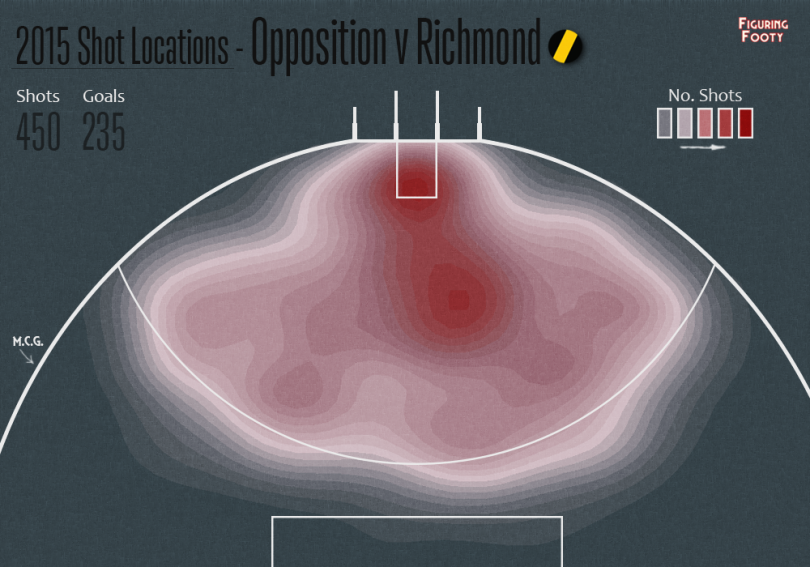This week’s post features a contribution from the excellent Figuring Footy, aka Rob Younger. If you don’t already follow him/read his work, get around it ASAP!
After a weekend of big upsets, HPN thought we’d take a step back and reassess the league as it sits after seven weeks. With Adelaide finally registering their first loss, immediately after we talked them up, we currently sit at the spot that is (practically) inevitable each year; no team is invincible, and no side utterly hopeless.
Indeed, on the HPN Ratings even the outlying Crows have come back to the pack a little, with the previously mentioned long tail seeming even more pronounced.
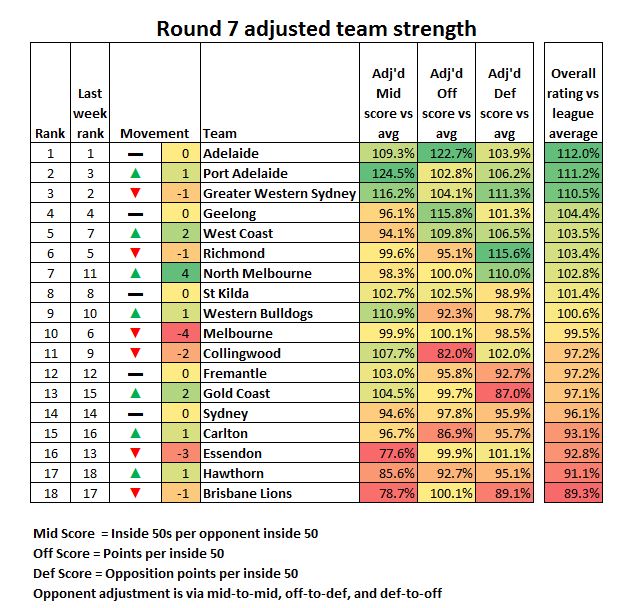
However, while we feel the ratings above are accurate reflections of the strengths and weaknesses of each side, they miss some of the colour of the play of teams. As such, we thought it appropriate that we look at the differing styles of each side in the season to date.
Richmond Are The Anti-Arsenal (they won’t let you walk it in)
Perhaps the most surprising side of the 2017 season has been Richmond, which joyously means that we won’t hear any shitty “9th again” jokes. Good riddance.
The catalyst for the Tigers’ resurgence hasn’t necessarily come in the front half of the ground, but instead in the back 50. Compared to last year’s Richmond outfit, the Tigers have turned into a defensive wall, especially close to goal.
We asked Friend Of The Program and all-around top stats guy Rob Younger from Figuring Footy for a way to show this.
Compared with 2016, the Tigers have conceded nearly 200 fewer points in the first seven rounds, and 141 fewer ExpScore points as well. Where the goal square and close corridor was a mess of shots in 2016 (27 across the first seven games), the Tigers have nailed that door shut this year, only conceding 12 shots with 10m of goal.
THEY. WON’T. LET. YOU. WALK. IT. IN.
Richmond also had an alright defence in 2015, albeit with a slightly different focus:
The Tigers have kept a slightly right-leaning focus of their defence. This could perhaps be a product of where the opposition feels comfortable leading, a conscious effort to push right-footers to their non-preferred side or maybe just teams avoiding where Alex Rance stands. Whatever the reason for the lopsidedness, the Tigers have pushed the opposition opportunities out significantly, and denied almost anything near goals. Adelaide was able to work out a solution when the two sides met, but no other side has found a real counter to date. If they can somehow keep this type of defence up, they will be in premiership contention later this year.
Queensland’s Matador Defence
During summer the Queensland Bulls often run riot over the short grass of the Gabba, but this season (and for the last three as well) their co-tenant the Lions have been playing the other half of the bullfighting equation.
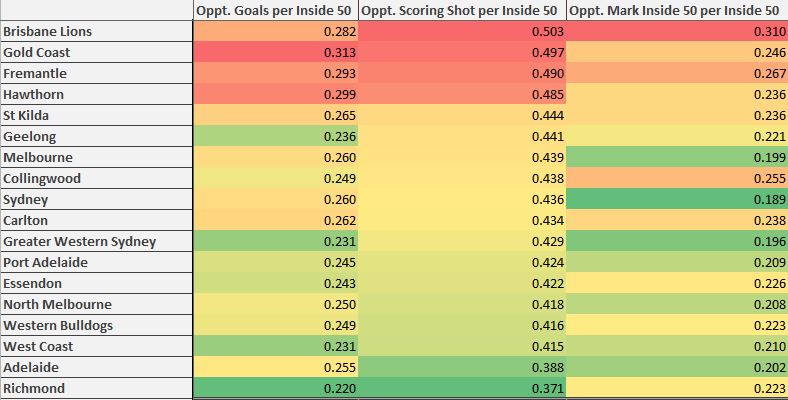
The Lions are currently last defensively as measured both by opposition scoring shots per inside-50 and by marks inside-50 per entry – both by a substantial margin. Their only real competition with respect to the former is the side that concedes the most goals per opposition inside 50 entry; their state-mates the Suns.
Both the Lions and the Suns have shown the ability to score in bunches this year, but when their midfield is beaten their respective back groups have been simply unable to keep the opposition at bay. Aggressive run and gun might be both sides’ only hope of victory, but it really hasn’t worked so far for the Lions in particular.
Kick First, Ask Questions Later
The kick v handball question is an old and nuanced issue. About a decade ago the pervasive thinking amongst football clubs moved from kicking where no other better option exists to looking for an extra handball to find a better target by foot.
As The Arc pointed out earlier this week, Carlton in 2017 is going a different way. The Blues are turning the clock back to a slightly happier time on Lygon Street.
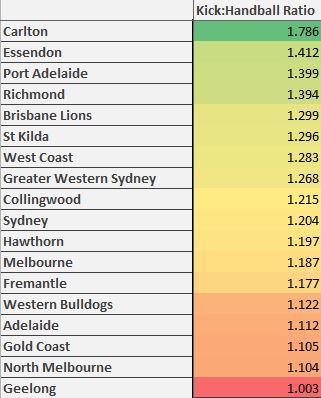
Carlton have played like a team that doesn’t know how to spell the word handpass, let alone execute one (citation required). There’s often benefit to “zigging” when almost every other side “zags”, even if the move is one back to an older age of footy. The weather that Carlton has faced may have something to do with the figures so far (Carlton have been to the MCG five times and Etihad once), but as our dads might say “THAT’S HOW FOOTY USED TO BE PLAYED.”
For GWS, Everything Is A Clearance Sale
We don’t think every team puts equal stock in winning clearances. A won clearance can still easily result in a turnover from the subsequent possession, and lead to the ball being rebounded back the other way. Clearances aren’t a great midfield strength measure in isolation, as they don’t correlate terribly well across the competition with inside-50 ratios or even with, you know, winning.
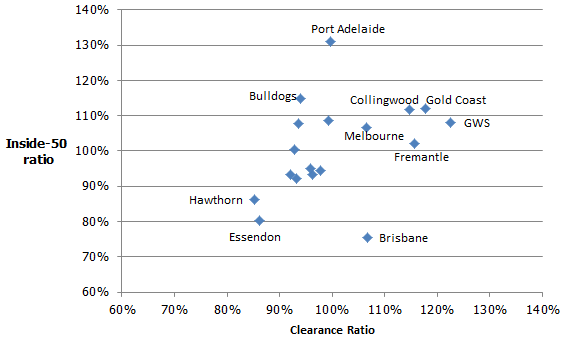
Adelaide and Port Adelaide, for instance, are doing pretty well on the scoreboard and in generating a predominance of inside-50 opportunities despite being indifferent break-even clearance sides. Port in particular have a very high ratio of inside-50s to opponent inside-50s despite not winning clearances, suggesting an outside midfield game that is working well.
However, a very high clearance ratio in a good team probably suggests they regard it as a strength and a tactical tool. Such may be the case with GWS, whose clearance ratio is a league high 122% and whose dominant wins in 2017 all match with games where they destroyed their opponents in the clearance stakes. A lot of analysis of GWS focuses on the wave running they do with their powerful and skilled runners, and they seem able to achieve this out of stoppages at will if teams aren’t sufficiently careful.
The games where GWS didn’t win a disproportionate share of clearances were those where they looked mortal. They lost the clearance counts to Adelaide (by 1) and St Kilda (by 11) and only just topped the Bulldogs (by 2) in their close win. Elsewhere, they did what they pleased and won accordingly.
We don’t have access to score sources, but we’re willing to bet the Giants do very well scoring from stoppages. We’d also speculate that sides who can win clearances can trouble the Giants. That could include Collingwood this weekend (who incidentally have never lost to the Giants)
What Fremantle’s ruck dominance means
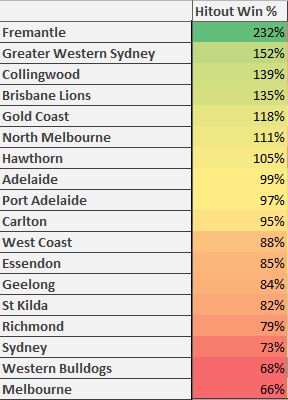
How do teams generate clearances? One obvious answer is by having a good ruckman. Fremantle, the side with the best ruckman, are also a good clearance-winning team. The top five sides for clearance ratios all also have positive hitout ratios (but not the other way around) which suggests rucks do still matter if you care about winning clearances.
Fremantle’s 115% clearance ratio is almost certainly partly a product of the towering presence of Aaron Sandilands. Gold Coast, GWS, Collingwood and Brisbane all also have pretty good primary ruckmen securing hitouts, and this may be part of what is translating into their relative clearance success. The Demons are a strange case which should probably be ignored for the moment – they’ve gone from having a really good ruckman to not really having one at all, so their season totals reflect both those situations.
This doesn’t mean that hitout domination necessarily translates linearly into midfield success, however. North Melbourne, for instance, are sixth in hitout differential, but lose the clearance counts on average. Fremantle are the key case study to what ruck dominance means. The Dockers themselves are generating more than two hitouts for every opponent hitout, which is an insane degree of dominance. But they’re also not translating those hitouts as efficiently into clearances as that might suggest.
The brute force effect of utterly dominating hitouts is only giving Freo a modest advantage in terms of winning the ball away from the area around a stoppage. This may suggest there is a saturation point of ruck dominance beyond which ruck contests get too predictable, and midfielders too evenly matched, to gain further advantage.



